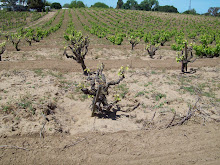
Well, the game is afoot!
Armed with our little map from the City of Oakley, Kath and I set about trying to identify some of the anonymous vineyards along the sides of Main Street. After which, we’d attempt to seek out wines from their grapes, made either by the vineyard owner, or the winemakers to whom the grapes were sold.
We knew that Cline still held extensive vineyards holdings here in the ‘hood, even though the family had moved their production facility to Sonoma years ago. Back in the day, i.e., the early decades of the 1900s, a substantial portion of Oakley vineyards made up the Jacuzzi ranch (yep, those Jacuzzis). Flash-forward a couple of generations, and the Cline side of the family has made its reputation by successfully transitioning from hot-tub fame to head-trained farming of old vines.
A little Web research also pointed out that Cline produced a few vineyard-designate Zinfandels from single vineyard sources, vineyards named after streets which we’d driven by over the last several months of Oakley residence: An old vineyard on Bridgehead Road would produce the Bridgehead Zin; likewise for Live Oak Avenue. (I’m reminded of an observation by poet Billy Collins, something along the lines of housing developers bulldozing all the trees and wildlife, then calling the project “Deer Ridge” or “Poplar Grove”: There’s a development near our house that’s called “Live Oak Ranch.” It’s none of the three.)
But the street most likely to fire the imagination of a newcomer is Big Break Road. I figured it had something to do with either “American Idol” or a terrible rail accident; turns out that a levee broke about 80 years ago, and flooded local farm acreage.
Kathy was able to order a bottle of the 2007 Big Break Zin online, and we tried it last night with a home-prepared dinner made primarily from the bounty of our newly joined Community Supported Agriculture selection, as well as from the Brentwood farmer’s market. A creamy avocado soup topped with our house-made apple-smoked salmon, an avocado/tomato salad, and favas and mint tossed with garlic, balsamic and olive oil, and topped with pecorino romano curls: A heavy-duty Zin at 16% alcohol might seem like an odd match. But there was absolutely nothing “hot” or heavy about this Big Break bad boy. With its color and whiffs of ripe plum, a nice, medium mouth weight, notes of white pepper and blackberry jam (not to mention lively hints of menthol — eucalyptus trees ring the vineyard property), the wine proved to be a freshly balanced complement to what was basically a vegetarian spring meal.

